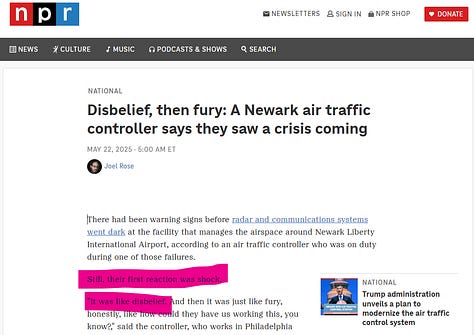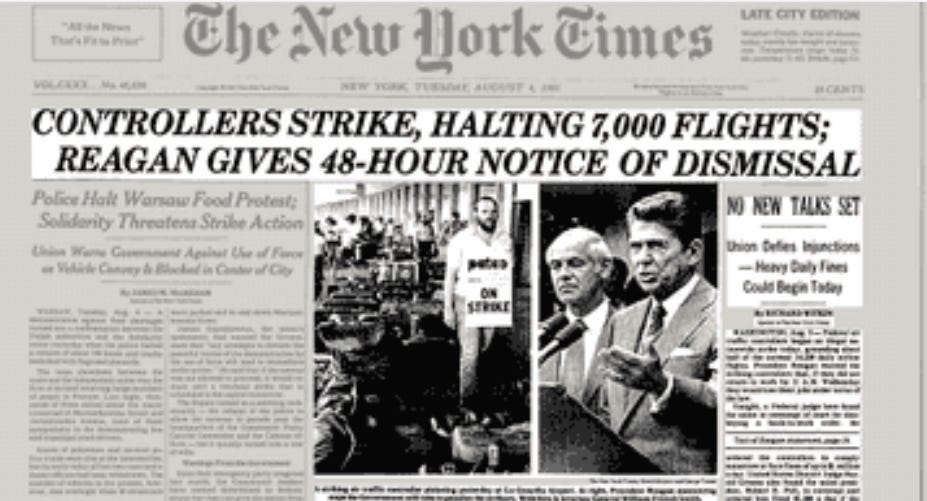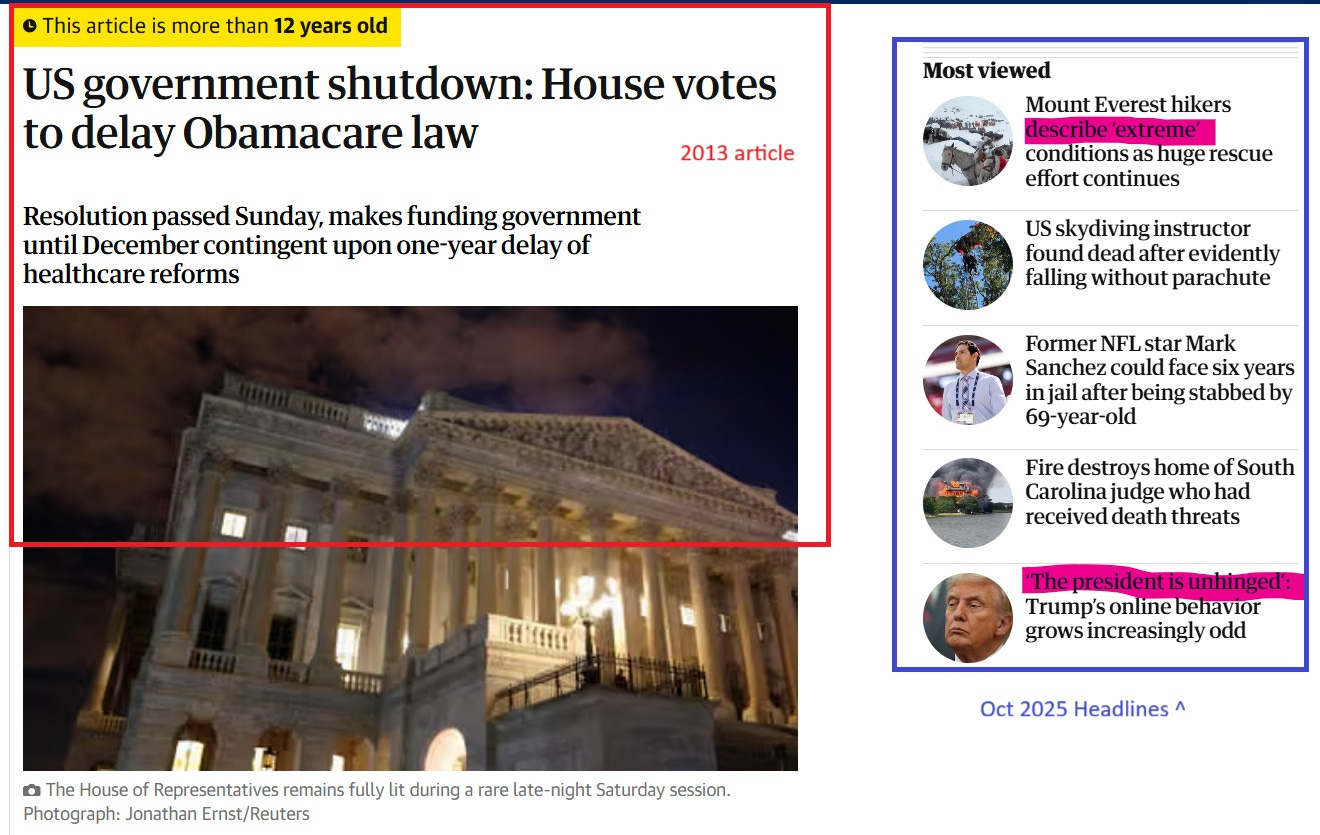Pre-Digested Reactions: How Short-Form Media Trains Us to Feel Before We Think
How headlines evolved from reporting facts to prescribing feelings — and what that means for modern media and marketing
Authors Note: Guess you’re getting the rough draft of this post early. Enjoy!
In the olden days of the 2000s, a headline told you what’s happening.
“Car crashed, 20 killed”
Now, headlines tell you how to feel before you even know what’s happening.
“My boss was crying.”
“Disbelief, then fury.”
“Trump adviser totally flips out.”
If I had to guess, you probably don’t know what the article is actually about.
But once you hit the headline — emotional framing is already loaded. You know the way you’re supposed to feel immediately.
“My boss was crying.” → I know to probably dislike this thing
“Disbelief, then fury.” → I should disagree with this FAA administration1
“Trump adviser totally flips out.” → Thing makes Trump mad
That’s “pre-digestion.” The content expects you to feel first, think later (if at all).



Contrast that with a very similar ATC headline from 1981 (Reagan’s firing of air traffic controllers):
“Controllers Strike, Halting 7,000 Flights; Reagan Gives 48-Hour Notice to Strikers.”
It’s not nearly as obvious if this should be a favored or disfavored action for a general reader.
No emotional cue. No forced direction.2 A real description of what’s happened.
That shift — from letting people decide how to feel → telling people how to feel instantly — is foundational to how all modern short form content, marketing, and media now function.
And if you’re building for real humans—for better or worse3—this matters.
Why “Pre-Digested” Content Is the New Default
Emotion is compressed meaning. If you can capture readers for 30 minutes, you can gradually build up an argument.
If you have half a second, you don’t have time for nuance.
The only short-form scalable unit is affect (the psychology term) — a fast, hind-brain, one-thought signal: anger, joy, shock, rage.Algorithms reward speed. Platforms reward immediacy. If users hesitate, scroll away, or don’t click fast, your content won’t be recommended again. Emotional priming is the minimal viable engagement.4
The leap to alignment. When someone sees “Trump melts down over X”, the emotional framing primes a binary alignment: “Am I for or against this?” It funnels group aligment before comprehension.
The Medium Is the Mood (And then the Mind)
Roderick Hart’s Seducing America5 (how the medium of TV affected 20th century politics) is a useful lens: media doesn’t just deliver meaning, it creates, curates, and conveys feeling. Across a large enough swath of people consuming that medium, it generates new forms of culture.
TV’s physical limitation—small screens—led to camera work that emphasized tightly-framed close-up shots of politicians.
That face-to-face intimacy made politics feel viscerally intimate. Interviewers started asking more personal questions. Viewers demanded more personal anecdotes.
Politics changed because of the technical medium on which it was conveyed.
Short-form6 is that intimacy + time compression.
Instead of saying “Here’s a candidate, their views, their record”, content now says “Here’s a moment — feel this immediately.”
The time gap between signal and meaning shrinks to nearly nothing.
It’s so short that the creator has to pre-digest the content so you know to leave that clip with a feeling: Group success, defeat, anger, etc
In effect: the medium (short video, shareable headline, tweet) becomes the message’s emotional scaffolding.
The form dictates both the emotional architecture and payload.
How do I Market in a World of Instant Emotional Cues
If your customer now lives on the bleeding edge of reaction engineering7, traditional persuasion is too slow but traditional concepts are not.
Emotional scaffolding first. Begin with a micro-signal (anger, delight, curiosity) that primes the context.
Layer Depth for those who look. Layer proof, nuance, narrative after you’ve won attention emotionally. You don’t need to capture everyone—but you need material that will be valuable for those looking. Funnel management is key for understanding your customers here.
Think in “snacks + meals.” The short form is your hook; the longer content is where you justify, explore, and add true value. Is this me re-packaging the Hub-Help-Hero strategy? Maybe
Authority by association, not argument. The NBC News campaign “Trust the Source. Choose the Screen.” doesn’t argue. It anchors trust, choice, and medium — all in six words. That’s pre-digested persuasion.8
If your content can’t produce a visceral gut reaction in <2 seconds, you may lose before you begin.
Everything Must End with a Verdict
Even in “neutral”9 domains we see this. Consider Extranet Shaquille’s10 cooking shorts.
He compares common kitchen ingredients — no conclusion. But viewers (on shorts) demand one: “Which is better?” “Which should I use?”
The audience isn’t asking for an understanding of the options — they’re asking for a feeling. They expect the content creator to do the thinking.
This is the signal: in short-form culture, ambiguity feels lazy. The content must leave you with a more lasting emotion.
“Milk is bad” is a more likely-to-be-shared conclusion than “Milk can be useful depending on your diet, tolerance, and health goals” on a short video.
Conclusion
Design for humans, not algorithms.
You don’t have to surrender to emotional speed. But you must understand it.
Start with reaction, then reward curiosity. Hook emotionally, then invite deeper thinking.
Segment content by thinking depth. Let short-form be the hook; mid and long-form be the journey. Keep track of what you intend to convey, how you intend to do it, and how well that material worked.
Measure retention in time and purchase behavior, not just clicks. Track whether your audience stays to think and buy. (and don’t get me started on fradulent metrics)
It’s foolish to be the best buggy whip salesman when you see cars on the road. But you don’t have to become a car acolyte to learn from their successes.
Pay attention to how your customers consume and manage your strategy based on first principles from that.
Post Script Conclusion
System 1 vs System 2: Why We Default to Reacting
Daniel Kahneman11, in Thinking, Fast and Slow, distinguishes two thinking systems:
System 1 (Instinct and emotion) = fast, automatic, emotional
System 2 (Rationality and considered thought) = slow, deliberative, logical
Short-form content recruits System 1 by design: emotion first, reasoning never required. System 2 is lazy — it only engages when forced.12
Short-form content is built to bypass thought and install emotion.
But we lose a lot of what makes us human with short form
Short-form isn’t just compressed in time; it’s truly reductive.
Nuance shrinks. Complex issues must squeeze into binaries (or ternaries) or die.
Signal & Frame. The winner is the person who frames fastest, not most truthfully.
You outsource your interpretive work. You read what’s annotated emotionally. But you miss what’s argued and presented. You become dependent on your source for understanding.
As media shrinks temporally, so does deliberation. We’re now risking a culture where everyone has emotions but there’s no value to abstract principles or concepts. Everything is becoming a disjoint, knee-jerk reaction to what’s here right now.
I don’t know how to fight the massive forces (evolutionarily and economic) that lean into short form content, but the West was only made truly great through its adoption of long-form linear thinking and the writing that conveyed that.
We shouldn’t lose that superpower because its less fun than a pre-digested meal.
A really damning part of the article that’s unaddressed is that the (unsourced) ATC operator actually tells the interviewer:
The Newark controller told NPR they would not use the airport, either.
“My best friend asked me the other day, like, ‘I got a Newark flight, is it going to be fine?,’” they said. “I was like, no, don’t fly out of Newark. Like, at the very least you’re going to be delayed. But no, like, I’ve had to book flights and Newark is the cheapest and most convenient option, nine times out of ten. And I’m not going to do it.”
But has made no official reports to the FAA about what to fix (other than literally asking for “less (sic) airplanes”.
If we’re expected to relate to an unnamed source that is guiding our airplanes without quitting, who is privately advising friends on important safety matters rather than bringing them up through official channels, the only way to make that sympathetic is through emotional pre-digestion.
I’m aware of longer-term media slant. But in the context of this kind of emotional framing, we’ve gone from maybe 2/10 to 10/10 in the last decade.
its for worse.
An interesting note (of somewhat active research): The Supplementary Motor Area (SMA) is a brain region that seems to be responsible for pre-planning ordered steps for compound motor actions.
For example, if you wanted to stand up and walk to get water, you need to manage posture, coordinate all your leg muscles firing, and your arm to hold a glass of water. The SMA pre-plans how to execute these actions while you’re considering moving—before you’ve actively decided what exactly you’re going to do.
It’s possible that your SMA will be primed to click on emotionally-salient content where your forebrain confabulates the reason as something more high-brow later.
A great phenomenology about TV’s active shaping of collective feeling
Both video and text
AKA being in the state McLuhan describes:
Electromagnetic technology requires utter docility and quiescence of meditation such as befits an organism that now wears its brains outside its skull and its nerves outside its hide
Do I think this is an ethical and rational way to build trust? No, but I’m writing to tell you how to win, not what is the optimal society-building structure.
He won the Nobel Prize for this research.
Kahneman argues that System 1 operates continuously and effortlessly, churning out impressions, feelings, intuitions. System 2 is lazy, skeptical, and requires mental effort to engage.
Because human attention is limited, System 1 tends to dominate — especially when media is optimized to distract from thought.
I’m not sure we could argue that there’s ever a ‘neutral’ topic. Everything that is algorithmically shared or deprioritized expresses some form of synthetic value system.
Cooking at home often conveys values of health and culture, while eating out conveys convenience and a focus on flavor. The field of the political is expansive.
To be perfectly honest, I’m not sure who has talked about this more in depth, but I’m sure Derrida or Kittler have something to say about it.
I will continue to reference him (and specifically this great video) until he includes me on a cooking video cameo.




